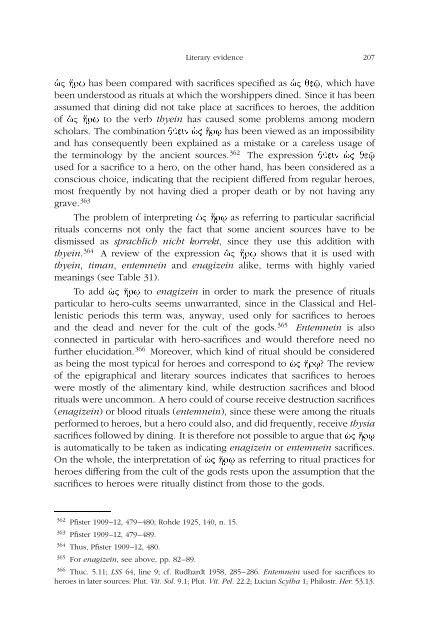The sacrificial rituals of Greek hero cults in the Archaic to the early ...
The sacrificial rituals of Greek hero cults in the Archaic to the early ...
The sacrificial rituals of Greek hero cults in the Archaic to the early ...
Create successful ePaper yourself
Turn your PDF publications into a flip-book with our unique Google optimized e-Paper software.
Literary evidence 207<br />
v rÿ has been compared with sacrifices specified as vje§, which have<br />
been unders<strong>to</strong>od as <strong>rituals</strong> at which <strong>the</strong> worshippers d<strong>in</strong>ed. S<strong>in</strong>ce it has been<br />
assumed that d<strong>in</strong><strong>in</strong>g did not take place at sacrifices <strong>to</strong> <strong>hero</strong>es, <strong>the</strong> addition<br />
<strong>of</strong> v rÿ <strong>to</strong> <strong>the</strong> verb thye<strong>in</strong> has caused some problems among modern<br />
scholars. <strong>The</strong> comb<strong>in</strong>ationjúe<strong>in</strong> v rÿ has been viewed as an impossibility<br />
and has consequently been expla<strong>in</strong>ed as a mistake or a careless usage <strong>of</strong><br />
<strong>the</strong> term<strong>in</strong>ology by <strong>the</strong> ancient sources. 362 <strong>The</strong> expression júe<strong>in</strong> v je§<br />
used for a sacrifice <strong>to</strong> a <strong>hero</strong>, on <strong>the</strong> o<strong>the</strong>r hand, has been considered as a<br />
conscious choice, <strong>in</strong>dicat<strong>in</strong>g that <strong>the</strong> recipient di�fered from regular <strong>hero</strong>es,<br />
most frequently by not hav<strong>in</strong>g died a proper death or by not hav<strong>in</strong>g any<br />
grave. 363<br />
<strong>The</strong> problem <strong>of</strong> <strong>in</strong>terpret<strong>in</strong>g v rÿ as referr<strong>in</strong>g <strong>to</strong> particular <strong>sacrificial</strong><br />
<strong>rituals</strong> concerns not only <strong>the</strong> fact that some ancient sources have <strong>to</strong> be<br />
dismissed as sprachlich nicht korrekt, s<strong>in</strong>ce <strong>the</strong>y use this addition with<br />
thye<strong>in</strong>. 364 A review <strong>of</strong> <strong>the</strong> expression v rÿ shows that it is used with<br />
thye<strong>in</strong>, timan, entemne<strong>in</strong> and enagize<strong>in</strong> alike, terms with highly varied<br />
mean<strong>in</strong>gs (see Table 31).<br />
To add v rÿ <strong>to</strong> enagize<strong>in</strong> <strong>in</strong> order <strong>to</strong> mark <strong>the</strong> presence <strong>of</strong> <strong>rituals</strong><br />
particular <strong>to</strong> <strong>hero</strong>-<strong>cults</strong> seems unwarranted, s<strong>in</strong>ce <strong>in</strong> <strong>the</strong> Classical and Hellenistic<br />
periods this term was, anyway, used only for sacrifices <strong>to</strong> <strong>hero</strong>es<br />
and <strong>the</strong> dead and never for <strong>the</strong> cult <strong>of</strong> <strong>the</strong> gods. 365 Entemne<strong>in</strong> is also<br />
connected <strong>in</strong> particular with <strong>hero</strong>-sacrifices and would <strong>the</strong>refore need no<br />
fur<strong>the</strong>r elucidation. 366 Moreover, which k<strong>in</strong>d <strong>of</strong> ritual should be considered<br />
as be<strong>in</strong>g <strong>the</strong> most typical for <strong>hero</strong>es and correspond <strong>to</strong> v rÿ? <strong>The</strong> review<br />
<strong>of</strong> <strong>the</strong> epigraphical and literary sources <strong>in</strong>dicates that sacrifices <strong>to</strong> <strong>hero</strong>es<br />
were mostly <strong>of</strong> <strong>the</strong> alimentary k<strong>in</strong>d, while destruction sacrifices and blood<br />
<strong>rituals</strong> were uncommon. A <strong>hero</strong> could <strong>of</strong> course receive destruction sacrifices<br />
(enagize<strong>in</strong>) or blood <strong>rituals</strong> (entemne<strong>in</strong>), s<strong>in</strong>ce <strong>the</strong>se were among <strong>the</strong> <strong>rituals</strong><br />
performed <strong>to</strong> <strong>hero</strong>es, but a <strong>hero</strong> could also, and did frequently, receive thysia<br />
sacrifices followed by d<strong>in</strong><strong>in</strong>g. It is <strong>the</strong>refore not possible <strong>to</strong> argue that v rÿ<br />
is au<strong>to</strong>matically <strong>to</strong> be taken as <strong>in</strong>dicat<strong>in</strong>g enagize<strong>in</strong> or entemne<strong>in</strong> sacrifices.<br />
On <strong>the</strong> whole, <strong>the</strong> <strong>in</strong>terpretation <strong>of</strong> v rÿ as referr<strong>in</strong>g <strong>to</strong> ritual practices for<br />
<strong>hero</strong>es di�fer<strong>in</strong>g from <strong>the</strong> cult <strong>of</strong> <strong>the</strong> gods rests upon <strong>the</strong> assumption that <strong>the</strong><br />
sacrifices <strong>to</strong> <strong>hero</strong>es were ritually dist<strong>in</strong>ct from those <strong>to</strong> <strong>the</strong> gods.<br />
362 Pfister 1909–12, 479–480; Rohde 1925, 140, n. 15.<br />
363 Pfister 1909–12, 479–489.<br />
364 Thus, Pfister 1909–12, 480.<br />
365 For enagize<strong>in</strong>, see above, pp. 82–89.<br />
366 Thuc. 5.11; LSS 64, l<strong>in</strong>e 9; cf. Rudhardt 1958, 285–286. Entemne<strong>in</strong> used for sacrifices <strong>to</strong><br />
<strong>hero</strong>es <strong>in</strong> later sources: Plut. Vit. Sol. 9.1; Plut. Vit. Pel. 22.2; Lucian Scytha 1; Philostr. Her. 53.13.



